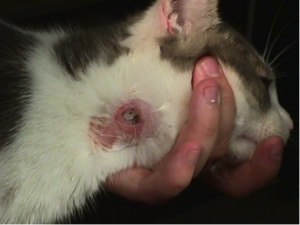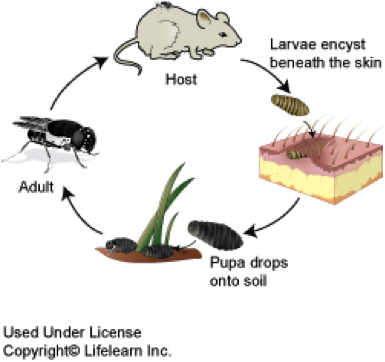It sounds like something straight out of a science fiction novel… you notice a bump on your pet, you take a closer look and you see a small hole with something moving inside. A big, juicy maggot emerges from your pet’s skin and plummets to the floor. This is Cuterebra.
As horrifying as it sounds, Cuterebra are quite common. What is a Cuterebra? Cuterebra fly species are also known as bot flies, and they are opportunistic in that they use small mammals (dogs, cats, rabbits, squirrels, etc.) to complete their life cycle.
The Lifecycle:
- The fly lays eggs on blades of grass or in the host’s nest (rabbits, mice), the eggs hatch and the larvae crawl onto the skin of the passing host. Dogs and cats get exposed but sniffing around or sticking their heads into these nests.
- The small maggots enters a body orifice (mouth, nose, eyes, ears or open wound), migrates through various internal tissues, and eventually migrates to the skin where it makes a “warble” (lump or bump). The larvae make a small hole in the skin to breathe. This is when the parasite is usually discovered; a noticeable lump in the skin with a small hole.
- Once matured, roughly 30 days later, the maggot (now up to 1 inch long) drops out of the host to pupate in the soil and then becomes an adult fly.
- All ages and breeds of dogs and cats may be affected. Cuterebra are mainly seen during mid to late summer, or nearly year round (southern states) when flies are most active.
Symptoms/Side Effects:
- Neurologic disease – (most common form in cats) – larvae can migrate into the brain. Can cause dizziness, circling, and paralysis.
- Nasal irritation/respiratory – serious nasal discharge with sneezing as larvae migrate through nares. Can also cause respiratory distress with migrating through upper airway/throat and lungs. Cough, fever and shortness of breath may be noted.
- Eye lesions – when larvae migrate to the eye. Can cause blindness.
- Swelling of the face.
- Infection – the site or lump the Cuterebra was in may become infected.
It is very important NOT to squeeze the skin in hopes of getting the larva out. This can cause the larva to break apart, and cause the host animal to have a chronic infection or perhaps an anaphylactic reaction. Contact your veterinarian for proper and safe removal.
Treatment:
Treatment depends on when the condition is discovered. If the condition is diagnosed before the maggot leaves the skin, the maggot will be removed and the injured tissues will be debrided or surgically removed. Antibiotics are usually prescribed to combat any secondary bacterial infection.
If the condition is noticed after the maggot has left the skin, the infected area is cleaned and debrided and antibiotics prescribed.
By: CCR Kylie




